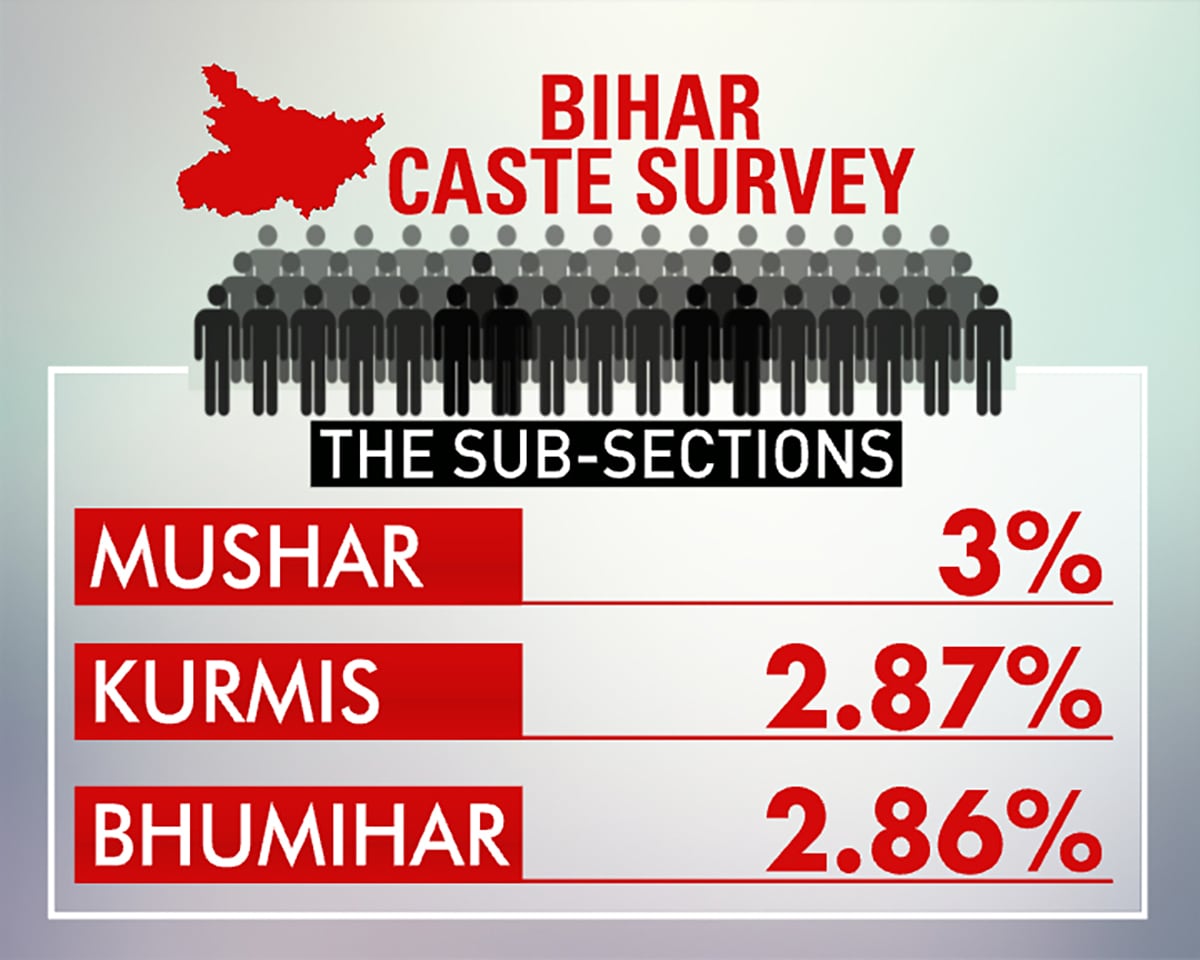The Bihar government on Monday released data from a controversial caste-based survey that said nearly 63.1 per cent of the state's 13.1 crore population belong to backward classes and nearly 85 per cent belong to either a backward or extremely backward class, or a Scheduled Caste / Tribe.
Specifically, 36 per cent of the state is from an extremely backward class, 27.1 per cent is from a backward class, 19.7 per cent is from a Scheduled Caste and 1.7 per cent is from a Scheduled Tribe. The general category, including so-called upper castes, account for 15.5 per cent.

The report also underlines the minority status of those who identify as Muslims in Bihar; they constitute less than 18 per cent of the population while those who identify as Hindus account for 82 per cent. In the 2011 Census these numbers were 16.9 per cent and 82.7 per cent, respectively.

A deep-dive shows the Yadav community - the group to which Deputy Chief Minister Tejashwi Yadav belongs - is the largest sub-group, accounting for 14.27 per cent of all OBC categories.

A further deep-dive shows that Kushwahas and Kurmis form 4.27 and 2.87 per cent of the population.

Brahmins constitute just 3.66 per cent of Bihar's people.

READ | Bihar Caste Survey: 27% Backward Classes, 36% Extremely Backward Classes
The data - coming months before next year's Lok Sabha poll - underlines the electoral importance of OBCs and marginalised communities - both for the BJP, which has opposed calls for a national caste census, and the opposition, which has been increasingly more and more vocal on the subject.
Over the past five Lok Sabha polls, the BJP has won over OBC votes at the expense of the Congress.
In the 1999 national election the OBC vote division was even - 23 to 24 per cent. This jumped to 34 per cent to 15 per cent in 2014 and then a massive 44 per cent for the BJP five years later.
READ | Bihar Caste Survey Results Out, Nitish Kumar Shares The Plan Ahead
In Bihar, that 63 per cent OBC+ EBC is a headline number for the BJP. In 2019 the BJP-led NDA won 39 of the state's 40 seats; the BJP won 17, JDU (then its ally) 16 and the Lok Janshakti Party got six.
The BJP and its allies, then, benefitted from OBC votes, as they did in the 2020 Bihar election, when 81 per cent of Kurmis, 51 per cent of Koeris, and 58 per cent of other OBCs/EBCs voted for them.
Representation, though, hasn't always been equal to population - a point Congress MP Rahul Gandhi made when he said only three of 90 Secretaries to the Indian government were from OBCs.
READ | "Important To Know Caste Statistics Of India": Rahul Gandhi On Census
In fact, comparing the 2015 Bihar Assembly to the 2020 one shows a drop in MLAs from OBC and EBC communities from 48.6 per cent to 40.7. MLAs from the so-called upper castes increased from 23.9 per cent to 29.2 per cent, while those from the Muslim community fell from 9.9 to 7.8 per cent.
The party-wise division of these numbers identifies the BJP as having only 27 MLAs from OBC communities (compared to 34 from so-called upper castes). For the JDU this split was 22-10.
The RJD skew was even bigger in terms of OBC representation - 39-13.
Meanwhile, what the Bihar caste survey report also does is spotlight the significance of OBC + EBC communities for the BJP, the Congress and all political parties across the country, with particular focus on states voting this year - Madhya Pradesh, Chhattisgarh, Rajasthan, Mizoram and Telangana.
In Telangana OBCs (as a percentage of households in rural areas) account for over 57 per cent. In Chhattisgarh that number is 51.4 per cent. This is 46.8 in Rajasthan and 42.4 in Madhya Pradesh.
The Bihar caste survey has been a polarising topic among India's political parties, with battle lines drawn between (primarily) the ruling BJP on one side and a number of opposition parties on the other.
Prime Minister Narendra Modi, at an election event in Madhya Pradesh's Gwalior today, hit out at those "trying to divide the country in the name of caste" - seen as a sharp response to Bihar's caste survey.
READ | "Trying To Divide Country...": PM After Bihar Releases Caste Survey Report
The INDIA bloc, which is pushing for a national caste census to ensure better targeting of development initiatives, has been boosted by the Bihar report. Rahul Gandhi - whose Congress is part of INDIA - said his party will order a similar exercise if it wins the Madhya Pradesh election due this year.
Track Latest News Live on NDTV.com and get news updates from India and around the world

